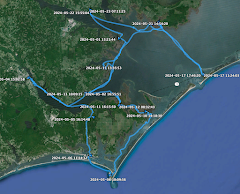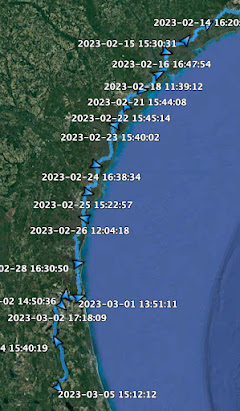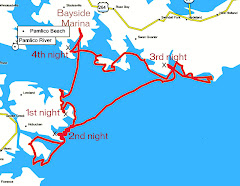A couple of email questions were waiting for me this morning, questions I'm glad to answer as it reminds me of being on the water. Keep in mind these are my solutions. They may not be the "right" way or the "best" way, but simply what works for me.
Paul of Perth Australia, who is switching from a gunter rigged Navigator to a gaff-rigged Pathfinder, asked about Spartina's rigging. Paul's Pathfinder came with sprit boom, which is drawn on the Pathfinder's sail plan, and I take it from his email he is considering switching to a conventional boom.
I chose not to use the sprit rig as drawn for two reasons. One, I was unfamiliar with the sprit rig and was not sure how to use it. And secondly, the early photographs of the first couple of Pathfinders showed the boats on the beach with a sprit boom and a pile of mainsail lying in the cockpit. At anchor or on the beach I wanted a clean, empty cockpit.
Spartina's rigging plan is taken from my last boat, a modified gaff-rigged Sam Devlin Nancy's China. I stole that rigging plan from a November 1986 Small Boat Journal article (which I still have) about "Dynamite" Payson's Bobcat, above. There's a topping lift to keep the boom raised and out of the cockpit, lazy jacks to cradle the mainsail and gaff when the sail is lowered, and both throat and peak halyard to raise the main. You can see in the photo at the top (one of Roger's nice photos from Downrigging Weekend), which shows me at the tiller, Dave (Baydog) at left and Dave's brother Huck, center, that I also use lazy jacks on the mizzen. (This was in the brief moment that Dave let me handle the tiller on the Chester River. He soon looked at me and said "I'm taking the tiller," not "could I take the tiller?" "mind if I take the tiller?" or "at some point, could I handle the tiller?" No, it was "I'm taking the tiller." ) That may seem like a lot of lines, but it is not. When rigging, two bronze clips connect the boom portion of the lazy jacks to the mast portion, one each bronze clip for the peak and throat halyards, and the topping lift is always connected.
I have been told that with a conventional boom I would also need a boom vang. I have experimented with a boom vang over the years, never with success. I no longer use one.
The purchase points for the main sheet have also changed over the years. Now the main sheet, and I think this is for the best and most likely the way the main sheet will remain, is a 4:1 purchase that runs from a block on the centerboard trunk to a block on the boom near the clew of the main. I'm very happy with that set up. Simple, clean and with the 4:1 purchase there is no problem managing the main in any kind of wind.
Above is the cockpit at anchor on Jones Bay, anchored the night before heading back into Hobucken on a cruise. Mainsail, gaff and boom are all nestled in the lazy jacks, plenty of room in the cockpit for me and the cruising gear.
Paul, let me know if you have any more questions.
---------------------------------------------------
Seth, who is building a Pathfinder up in the mountains of Virginia, had noticed the layers of wood on Spartina's rub rails and asked about the reasons for this. I would like to say this is a well thought out design innovation, but really it is the result of my poor choice in building materials.
While building Spartina I had become enamored with quarter sawn douglas fir. This worked wonderfully on the masts and spars, the quarter sawn wood exposing more grain and adding to the texture and richness of the wood. Liking that look so much, I used quarter sawn douglas fir for the rub rails. Big mistake. It took no time at all to realize that while the exposed grain looked good, it was very vulnerable to impact. Bumping up against pilings and piers quickly took a toll on the rails.
My solution was to layer over about a four foot section of the rub rail with mahogany, a much harder and durable wood. This was on the midship section of the rub rails, the area that gets the most impact. On top of that I put a piece of silicon bronze half oval, which protects the mahogany, which protects the douglas fir, which protects the boat. All in all, a pretty solid rub rail.
If I were to do it again I would start with a harder type of wood, one that could take the wear and tear, steam bend it to fit, and then put that half over on top to it. That half oval, which is moderately priced and is easy to work with (drilling pilot holes, rounding ends, etc) absorbs 90% of the beating that rub rails can take.
I hope that helps, Seth.















































5 comments:
Steve, thanks, this is very helpful. The extra wood on Spartina blends right in and looks like a deliberate feature. Great idea on the half-oval too.
Seth
Dear Steve, thank you for this instructional post. On my boat I am using the main lazyjacks also as topping lift and so far it has worked well for me.....
Lorenzo,
I can definitely see that as a possibility. The lazy jacks serve at a topping lift on my mizzen. Drop the mizzen and the sail is cradled in the jacks and the mizzen booms stays horizontal. Very nice.
steve
Steve, not sure your mahogany-over douglas fir helped much in the ding resistance wars.. Meranti isn't much harder (in compression) and okoume is a lot softer than DF, especially vertical-grain (quarter-sawn).
Bronze, on the other hand...
I don't doubt you on the wood hardness, but that quarter sawn douglas fir was getting spread flat with each bump, grain separating in places. Layering can't hurt, and you are right about the bronze.
As tell people who have asked me about boat building, I'm not a boat builder, just a guy that wanted a boat. steve
Post a Comment